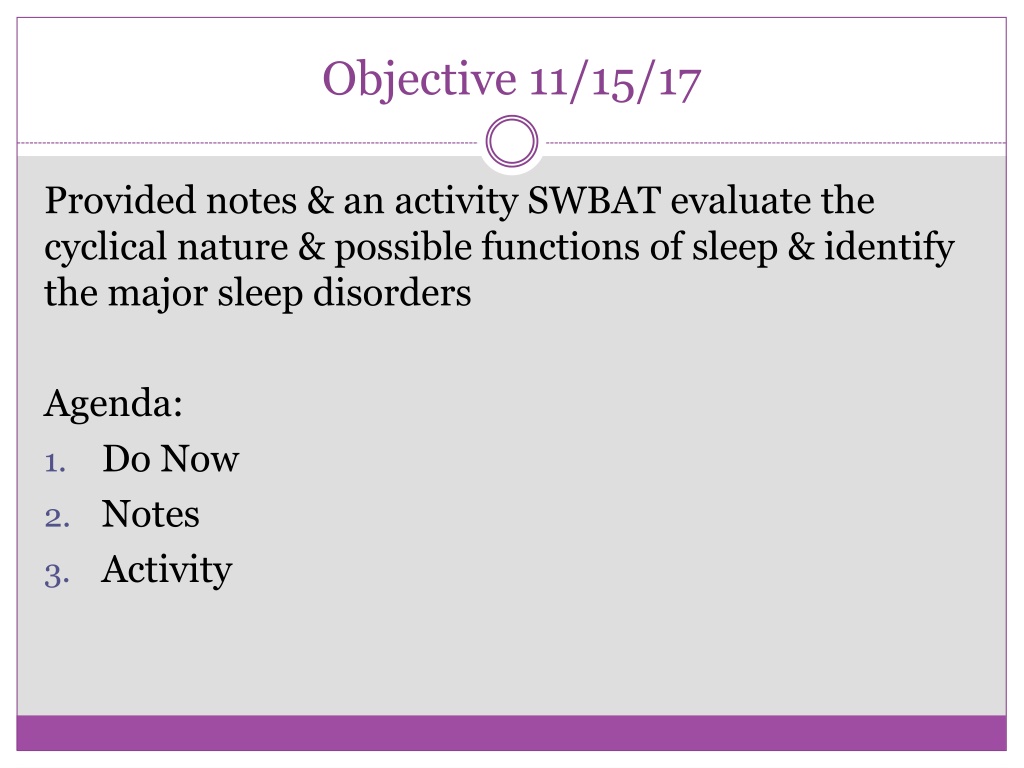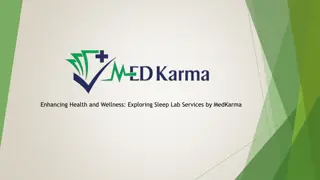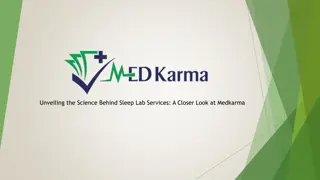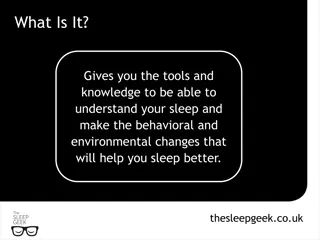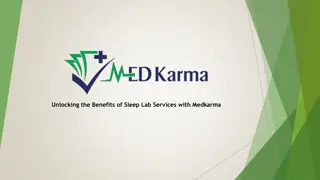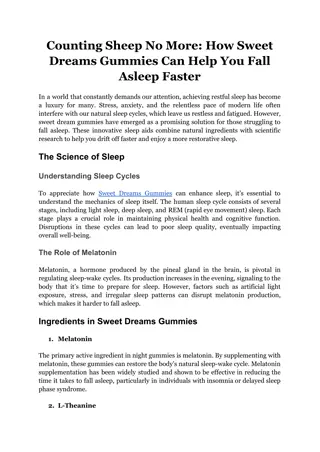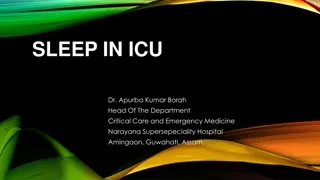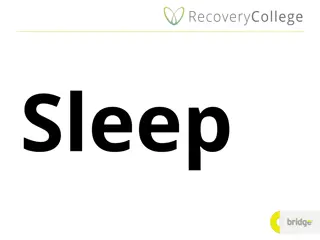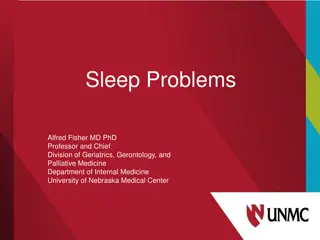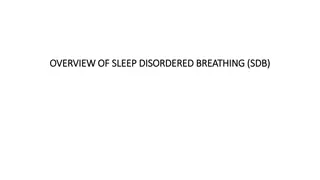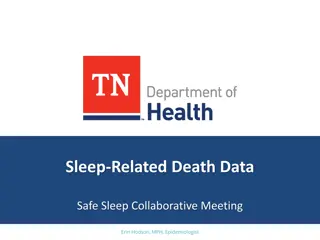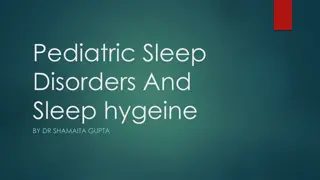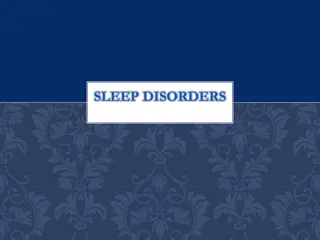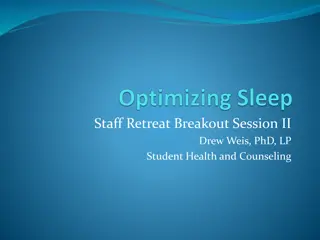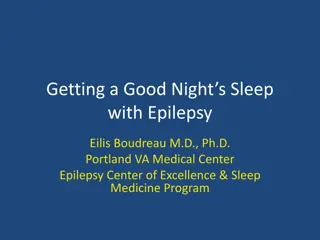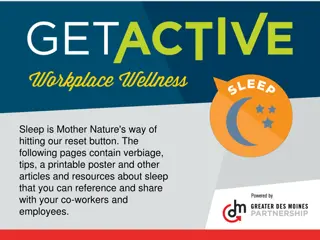Sleep Patterns, Disorders, and Functions
Explore the cyclical nature of sleep, functions of sleep, and major sleep disorders in this insightful session. Delve into biological rhythms, annual cycles, 24-hour cycles, and more to understand the intricacies of sleep patterns. Discover the impact of sleep on physiological functioning and learn about common myths through engaging activities and informative notes.
Download Presentation

Please find below an Image/Link to download the presentation.
The content on the website is provided AS IS for your information and personal use only. It may not be sold, licensed, or shared on other websites without obtaining consent from the author.If you encounter any issues during the download, it is possible that the publisher has removed the file from their server.
You are allowed to download the files provided on this website for personal or commercial use, subject to the condition that they are used lawfully. All files are the property of their respective owners.
The content on the website is provided AS IS for your information and personal use only. It may not be sold, licensed, or shared on other websites without obtaining consent from the author.
E N D
Presentation Transcript
Objective 11/15/17 Provided notes & an activity SWBAT evaluate the cyclical nature & possible functions of sleep & identify the major sleep disorders Agenda: Do Now 2. Notes 3. Activity 1.
Do Now The Sleep Myths Quiz-How much do you know?
States of Consciousness AP PSYCHOLOGY: UNIT 4 Topic: Patterns, Theories, Disorders, and Dreams
Consciousness: Biological Rhythms & Sleep PART ONE
Consciousness: Biological Rhythms Biological Rhythms Periodic fluctuations in physiological functioning that the body MUST go through Impact body temperature, blood pressure, production of certain hormones, effectiveness of medications, etc. Annual cycles 28 day cycles 24 hour cycles 90 minute cycles
Consciousness: Biological Rhythms Annual Cycles On an annual cycle, geese migrate, grizzly bears hibernate & humans experience seasonal variations in appetite, sleep and mood Example Seasonal Affective Disorder (SAD) Mood disorder; dark winter months 28-day Cycles Menstrual cycle Also known as an Infradian Rhythms
Consciousness: Biological Rhythms 24-hour cycles 24-hour cycles of varying alertness (sleep-wake cycle), body temperature and growth hormone secretion Also known as Circadian Rhythms; controlled by the brain 90-minute cycles Humans experience various stages of sleep in a 90- minute cycle
Function Typical Circadian Rhythm Peak mental alertness and memory functions Two peaks; 9:00am & 9:00pm Lowest/highest body temperature 97 F at 4:00am/99 F at4:00pm Peak physical strength Two peaks; 11:00am & 7:00pm Peak hearing, visual, taste and smell sensitivity Two peaks; 3:00am & 6:00pm Lowest/highest sensitivity to pain 4:00pm/4:00am Peak degree of sleepiness Two peaks; 3:00am & 3:00pm Peak allergic sensitivity to pollen and dust Between 1:00pm and 1:00am ***All approximations; some variation does exist!!
Consciousness: Biological Rhythms The Hypothalamus Role The Suprachiasmatic Nucleus (SCN) A structure located deep within the hypothalamus; sensitive to changes in light; internal clock As daylight fades the SCN tells the pineal gland to secrete melatonin; SLEEPINESS! Melatonin A hormone that helps regulate daily biological rhythms Others? Serotonin? Body temperature? (both correlational )
Consciousness: Biological Rhythms Sleep, the Gentle Tyrant Two Kinds of Sleep REM Sleep (Rapid Eye Movement) NREM Sleep (Non-REM) Stage 1 Stage 2 Stage 3 Stage 4
Consciousness: Biological Rhythms Why do we spend a third of our lives sleeping? Preservation & Protection Theory Elimination of waste products Repair of cells and brain tissue Strengthens immune system Preserves energy Restoration Theory General wear & tear; recuperation; muscles & brain relax Memory Strengthens/rebuilds fading memories
Consciousness: The Sleep Stages PART TWO
Consciousness: Sleep Stages Stage 1: Light Sleep Brain Activity Alpha waves decrease; theta waves increase Characteristics Breathing slows; brain waves become irregular Occasional twitching Hypnagogic images Hypnic jerks Non-REM Easy to wake an individual in Stage 1 sleep; will insist that he or she WAS NOT sleeping!
Consciousness: Sleep Stages Stage 2: Sleep Spindles Brain Activity Brain wave (theta) cycle slows EEG sleep spindles develop; last 1-2 seconds Characteristics Sleep-talking The first time through Stage 2 lasts approximately 20 minutes Non-REM Still relatively easy to wake an individual in Stage 2 sleep
Consciousness: Sleep Stages Very difficult to wake an individual in Stage 4 sleep; will be confused and disoriented Stages 3 & 4: Deep Sleep Brain Activity Delta waves increase (larger & slower waves) Stage 3: 20-50% of total brain activity Stage 4: 50%+ of total brain activity; deepest stage Characteristics Growth hormones are released & peak during Stage 4 The body is at its lowest level of functioning Non-REM
Consciousness: Sleep Stages REM Sleep (Rapid Eye Movement) Brain Activity Brain waves resemble beta (waking) waves Characteristics Body temperature rises to near-waking levels Eyes move rapidly & heart rate increases REM Paralysis Voluntary muscles are paralyzed during this stage 90% of dreams take place during REM Sleep ***Sometimes referred to as paradoxical sleep
Consciousness: Sleep Stages Within any given night, humans generally pass through several 90-minute sleep cycles Stage 1 Stage 2 Stage 3 Stage 4 Stage 3 Stage 2 REM
Consciousness: Sleep Stages NREM versus REM? NREM physical needs REM emotional needs Potential function of REM dreams? Age and time spent in REM sleep? Age and differences in REM sleep? REM Rebound?
Consciousness: Sleep Issues http://www.sleepdisordersguide.com/blog/wp-content/uploads/2007/11/adult-sleep-walking.jpg PART THREE
Quiz: Are you Sleep Deprived? I need an alarm clock to ensure that I wake up at the appropriate time I struggle to get out of bed in the morning I hit the snooze button several times before I get up I feel tired, irritable and stressed out during the week I have trouble concentrating and remembering I frequently feel slow with regards to critical thinking, problem solving and being creative I often fall asleep while watching TV I often fall asleep during meetings or in warm rooms
Quiz: Are you Sleep Deprived? I often fall asleep after heavy meals I often fall asleep while relaxing after dinner I often fall asleep within five minutes of getting into bed I often feel drowsy while driving I often sleep extra hours on weekend mornings I often need a nap to get through the day I have dark circles under or around my eyes
Consciousness: Sleep Issues Sleep Deprivation Decreases the efficiency of the immune system Decreases productivity & the efficiency of memory Increases safety and accident issues Contributes to hypertension, impaired concentration, irritability, etc. Potential impact on weight?
Consciousness: Sleep Issues Insomnia Chronic problems in getting adequate sleep Three basic patterns Difficulty in falling asleep Difficulty in remaining asleep Persistent early morning awakening Causes? Anxiety, depression, health issues, drugs, etc. 1 in 10 adults complain of insomnia Common (though unhelpful) treatments Effect of alcohol and sleeping pills?
Consciousness: Sleep Issues Nightmares Anxiety-arousing dreams that lead to awakening, usually from REM sleep Difficulty in going back to sleep Usually occur in the early morning hours Generally associated with stress
Consciousness: Sleep Issues Night Terrors Abrupt arousal from NREM sleep (generally Stage 4) accompanied by intense autonomic arousal (e.g. rapid heart rate, perspiration, etc.) and feelings of panic Victims may scream or bolt upright & then stare into space; do not recall a coherent dream Panic fades quickly Most common in children ages 3 to 8 Night terrors are NOT nightmares!
Consciousness: Sleep Issues Somnambulism (Sleep-Walking) Occurs when a person arises and wanders about while sleeping; 15 seconds to 30 minutes Generally occurs during the first three hours of sleep 15% of children and 3% of adults exhibit persistent sleepwalking Generally goes away as one ages
Consciousness: Sleep Issues Narcolepsy Periodic and overwhelming sleepiness that leaves individuals falling asleep while talking or standing up May collapse directly into REM sleep; can last up to 5 minutes Sleep Apnea Failure to breathe when asleep; many repeated awakenings Most prominent in overweight males Loud snoring
Consciousness: Sleep Issues Bruxism Teeth grinding Enuresis Bed wetting
Consciousness: Dreams PART FOUR
Consciousness: Dreams Dreams Sequence of images, emotions & thoughts that pass through a sleeping person s mind Lucid Dreams Awareness of one s dreams Typically happens when the dreamer experiences something strange Stop to question their reality Realize they are in a dream
Consciousness: Dreams Average number of dreams? 4 to 5 times per night 90 minutes apart during REM (sleep cycle) Range First dream: 10 minutes Last dream: 30 minutes
Consciousness: Dreams Most researchers agree that dreams reflect our waking thoughts, fantasies and emotions Calvin Hall (dream researcher; 1966) Dreams reflect everyday & mundane events Dominated by emotionally significant people Almost ALWAYS from a first-person perspective Self-centered; we dream about ourselves Link between dreams and waking life? Day Residue (Sigmund Freud) External stimuli (William Dement & H2O) Culture and dreams?
Consciousness: Dreams Chased/pursued (81.5) Rapid falling (76.5) Sexual experiences (73.8) Teachers/studying (67.1) Being late (59.5) Verge of falling (57.7) Death (54.1) Trying again & again to do something (53.5) Flying/soaring (48.3) Failing exam (45.0) Being attacked (42.4) Frozen with fright (40.7) Back from the dead (38.4) Being a child again (36.7) Being killed (34.5) Swimming (34.3) Insects/spiders (33.8) Being nude (32.6) Being inappropriately dressed (32.5)
Consciousness: Dream Theories PART FIVE
Theory: Wish-Fulfillment Sigmund Freud The Interpretation of Dreams (1900) An expression of unconscious desires & internal conflicts; provide a safety valve by which to dispose of unacceptable feelings Unconscious may try to censor & disguise true meaning of dreams Manifest Content v. Latent Content What is required to decipher the latent content of one s dreams?
Theory: Cognitive Problem-Solving Rosalind Cartwright Dreams provide an opportunity to work through everyday problems & emotional issues; continuity between waking & sleeping thought Allows for creative thinking with regards to pressing personal issues because dreams are not restrained by logic or realism
Theory: Activation-Synthesis J. Allan Hobson (and McCarley) Dreams are the side effects of the neural activation that produces beta brain waves during REM sleep Neurons that fire periodically in the pons inhibit voluntary movement & send random signals to the cortex The cortex synthesizes/constructs a dream from memories and other stored information in order to make sense of these signals The frontal lobes are more-or-less shut down during dreaming; significance? Criticisms? Activation-Information-Mode Model (AIM)
Other Dream Theories Information Processing Dreams may help sift, sort and fix a day s experiences in our memories Physiological Function Dreams provide the sleeping brain with periodic stimulation to develop and preserve neural pathways
